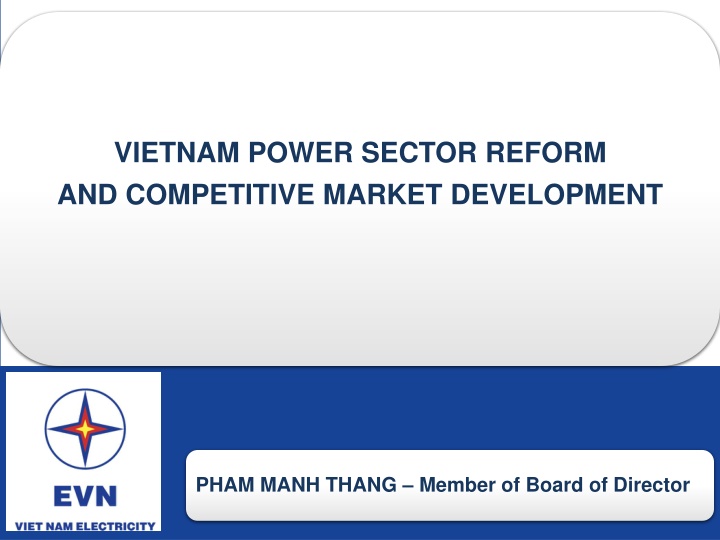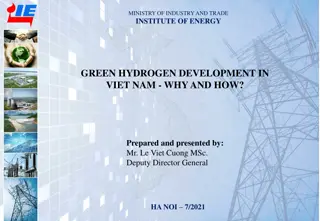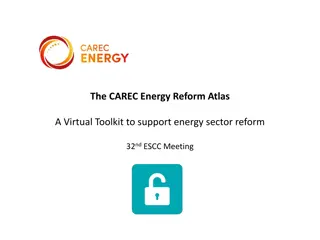Overview of Vietnam Energy Sector Reform and Market Development
Vietnam's power sector reform and market development have been key drivers in transitioning from a central planning economy to an open-market economy. This reform aims to adapt to global economic changes, enhance competitiveness, and ensure sustainable growth in the rapidly evolving energy landscape. With a focus on diversified energy sources, innovative market design, and operational efficiency, Vietnam is positioning itself as a dynamic player in the regional energy market.
Download Presentation

Please find below an Image/Link to download the presentation.
The content on the website is provided AS IS for your information and personal use only. It may not be sold, licensed, or shared on other websites without obtaining consent from the author.If you encounter any issues during the download, it is possible that the publisher has removed the file from their server.
You are allowed to download the files provided on this website for personal or commercial use, subject to the condition that they are used lawfully. All files are the property of their respective owners.
The content on the website is provided AS IS for your information and personal use only. It may not be sold, licensed, or shared on other websites without obtaining consent from the author.
E N D
Presentation Transcript
Vietnam Power Sector Reform Vietnam Power Sector Reform And Market Development And Market Development AND COMPETITIVE MARKET DEVELOPMENT VIETNAM POWER SECTOR REFORM Vietnam Power Sector Reform Vietnam Power Sector Reform And Market And Market Devvelopmentvvvv Devvelopmentvvvv Pham Manh Thang Pham Manh Thang Member of EVN Board of Director Member of EVN Board of Director PHAM MANH THANG Member of Board of Director 1
Contents 1. Overview of Vietnam Energy Sector 2. Electricity Reform Roadmap 3. Power Market Design and Operation 4. Lesson Learned 2
Overview of Vietnam Energy Sector 1. Potential Primary sources: Vietnam: a South East Asia country; area of 331,210 km2; population of 95 million; and per capita income of 2500 USD (as of 2018). Commercial potential of primary energy sources Coal 3.5 billion tones (33.4 million tone are used in 2017) Natural Gas 270 billion m3 (6 billion m3 are used in 2017) Hydro 110 billion kWh/year, (86.6 billion kWh in 2017) Wind 7.200 MW Solar 8.000 - 40.000 MW Geothermal 680 MW 4
Overview of Vietnam Energy Sector 2. Generation mix: Installed capacity by 10/2018 MW % 19,674 Hydro 40.25 18,430 Coal-fired 37.7 7.528 Gas-fired 15.4 1,500 Oil-fired 3.1 1,340 Import 2.75 403 Renewable 0.8 Total 48,875 Losses: 7.24% in 2017 Network Unit Quantity 500 kV transmission line Km 7,444 200 kV transmission line Km 16,551 110 kV distribution line Km 20,215 Medium and low voltage line (2015) Km 476,572 500 kV substation MVA 26,100 220 kV substation MVA 44,602 110 kV substation MVA 50,813 Medium and low voltage substation MVA 81,141 5
Overview of Vietnam Energy Sector 2. Generation mix (cont.) 2015 3% 2020 38537 MW 2% 7% 2% 0% 59779 MW 40% 30% 22% 16% 33% 45% 2030 1% 2025 112836 MW 8% 0% 4% 1% 21% 89074MW 18% 10% 19% 16% 51% 51% - VN power system is second largest system in Southeast Asia, 29th in the world - 99% of Vietnamese citizens have access to electricity 6
Power Sector Reform 1. Motivations for Power Sector Reform: - To adapt to the transition from central planning economy to opened market economy and globalization process. To introduce competition into power sector in order to increase efficiency and transparency in business and finally to have reasonable tariff to the end-users. To form a market platform to attract investment in generation in order to meet a constant high growth rate of demand (more than 14% per year during period 1995-2005). To have long term sustainable development of the industry (affordable price; environment issue; market signal for supplying side and demand side; government debt etc). - - - 8
Power Sector Reform 2. The Electricity Market Development Roadmap: Stage 1 Stage 2 Stage 3 Competitive Retail market Competitive Generation market (VCGM) Competitive Wholesale market (VWEM) (VREM) Trial run: 2011-2012 Trial run : 2017-2018 Trial run: 2021-2023 Official operation: 2012- 2018 Official operation: 2019- 2021 Official operation: 2023 9
Power Sector Reform 3. Power Sector Reform Implementation: Electricity law passed by Parliament 2004 Electricity Regulatory Authority of VN (Regulator) establishment Roadmap for electricity competitive market development issued by PM 2006 National Power Transmission Corporation (NPT) establishment 2008 Competitive generation market design approval, Mechanism for adjustment of market retail tariff isued EVN is asigned to be the single buyer for generation power market 2009 Establishment of 3 Gencos Competitive generation market officially in operation 2012 Starting Equitization process (Genco 3 is equitized in 2017) Network operation and retail in power distribution companies are separated Distribution companies become buyers in wholesale power market 2016- 2020 10
Power Sector Reform 4. VCGM Structure: Prices SMO Spot Market Spot costs Direct Trading Generators Bids IPPs SPPA (CfD) Spot revenue PV Power Dispatch SPPA (CfD) HPC BST Hanoi PC Tariff End User SPPA (CfD) TKV NPC BST Northern PC Tariff GENCO1 End User SPPA (CfD) Bids Single Buyer GENCO2 SPPA (CfD) CPC BST Central PC Tariff End User Electric Power Trading Company (EPTC) GENCO3 SPPA (CfD) Dispatch HPC Tariff BST HCM PC Equitised GENCOs End User SPPA (CfD) Indirect Trading Generators that are Traded by EPTC) HPC BST Southern PC Tariff End User BOTs PPA Non Contestable Customers SMHPs Transmission Distribution Generation Power Power Power 11
Power Sector Reform 5. VCGM Design: VCGM Common market design Cost based or price based Market model Cost based; energy payment and capacity payment (CAN) Gross pool and vesting contracts. Net pool or gross pool Single Buyer, Wholesale and Retail market Node pricing or uniform pricing Single Buyer Uniform pricing and constrains on payment Ex-post Marginal pricing. Determined based on price of last MW that meets the demand requirement. Price method setting Ex-ant or ex-post Pay as bid or marginal pricing Market structure MSO or SO and MO MSO integrated structure 12
Power Sector Reform 5. VCGM Design (cont.): Number pairs of quantity block/price Energy market Payment feature Full market price setting CAN setting 5 bidding quantities along with 5 bidding prices. Day ahead market 2 components: CfD contract and market payment. Equal to CAN (CapacityAdd-on) + SMP price. Determined and fixed for each hour for 1 year ahead. CAN is shortfall revenue of Best New Entrant. 1 hour Every generating unit has bid floor/cap. Trading interval Unit bid floor/cap 13
Power Sector Reform 6. VWEM Design: a. VWEM design is mostly based on VCGM design in term of spot market with flowing improvements: (i) transit from single buyer to multibuyers. (ii) Step by step moving from the cost based model to the price based model without CAN payment mechanism. (iii) Step by step shortening trading interval from 1hour to 15 minutes when the market information system available. b. In term of contracting framework: (i) CfD contract directly between market generators and PCs; (ii) Allocating existing PPAs from EVN to 5 others PCs. 14
Power Sector Reform 7. VCGM Results: Number of Power Plants in VCGM from 2012 to 2018 140 132 128 114 120 108 100 100 93 87 81 80 80 71 60 60 51 43 40 28 27 24 22 21 18 11 4 14 16 14 15 10 4 14 14 14 20 11 12 12 12 11 11 4 5 4 4 3 3 0 2012 2013 2014 2015 2016 2017 2018 Total Direct Indirect Temporarily Indirect SMHP BOT 15
Power Sector Reform 7. VCGM Results (cont.): SMP and FMP (SMP+CAN) prices SMP FMP 1 USD 22000 VND 16
Lesson Learned Legal framework: Power market development should be carried out in parallel with power sector reform (In Vietnam, power sector reform is approved and issued nearly every 5 years while power market development road map is approved for all stages of 20 years). Retail tariff adjustment mechanism and primary energy market should be introduced in conjunction with power sector reform and power market development (In Vietnam, domestic coal, natural gas price and uniform retail are regulated by Government) An electricity regulatory body should be established robustly and independently from state management agencies. A big power system with high demand growth rate of more 10% will require huge of capital to invest in generation. Hence, the market design should be cost-based first. 18
Lesson Learned Vietnam is currently lacking of primary energy markets, so transparency of fuel prices for power generation in power market environment is an big issue. A mechanism to put into operation of coal, oil and gas into energy market to ensure that the transactions on primary energy are fair, transparent and competitive. Electricity retail tariff is uniform throughout the country, not reflecting the supply demand equilibrium. In near future, it is necessary to implement the mechanism of having retail electricity prices by regions. 19
Thank you! Thank you! Vietnam Electricity 20 Address: 11 Cua Bac, Ba Dinh, Hanoi, Vietnam Tel: (84-4) 6.6946789 - Fax: (84-4)6.6946666























